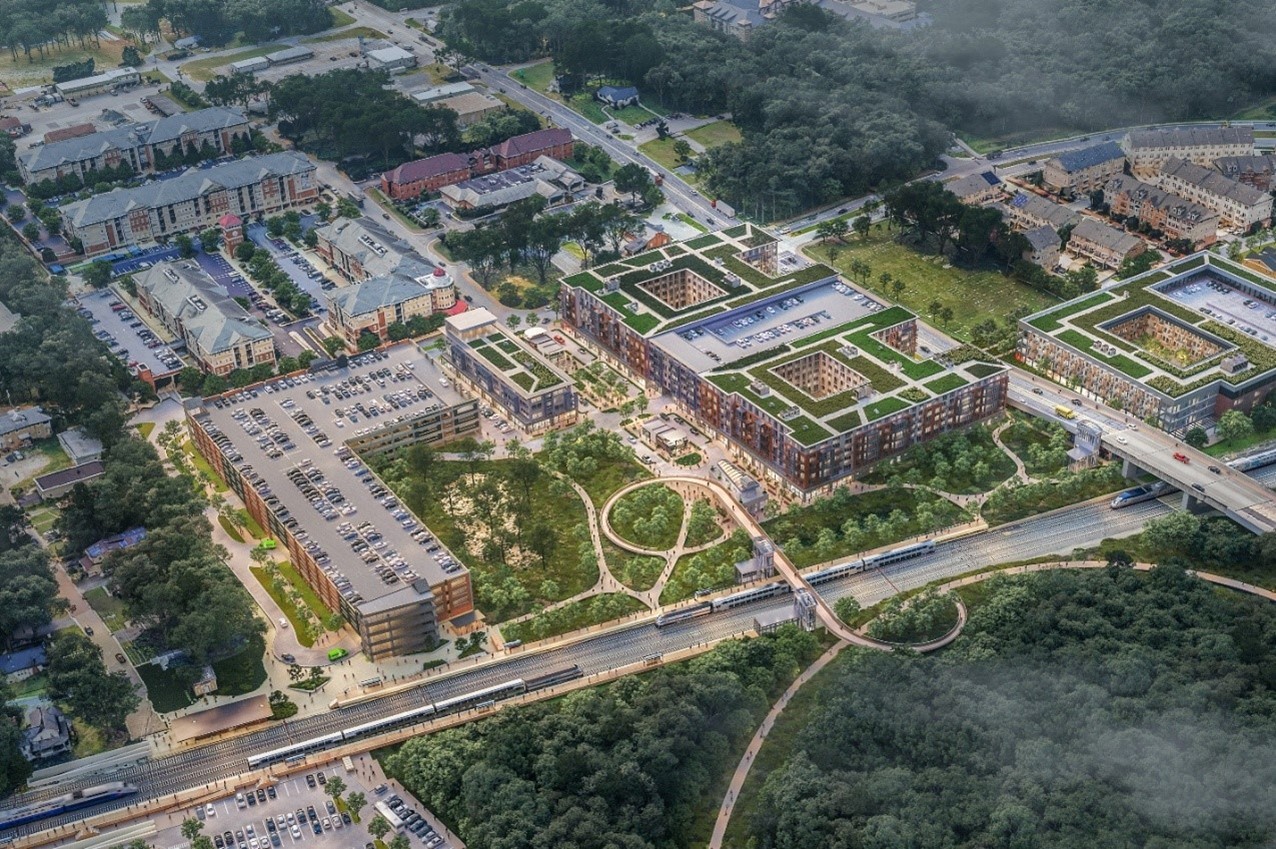
Rendering of the Proposed Bowie State MARC Station Joint Development. (MDOT Office of Real Estate and Economic Development)
Transit-Oriented Development (TOD) is becoming an increasingly powerful tool in cities across the U.S. and around the world. By focusing development around public transit stations, TOD helps increase access to transit, expands the housing supply (including affordable housing), creates jobs, boosts local economies, and generates long-term revenue for communities. It also makes smarter use of our existing transit systems, helping people live, work and travel more efficiently and sustainably.
At its core, TOD is dense, mixed-use development built around transit stations. But successful TOD takes thoughtful planning and, most importantly, strong partnerships between the public and private sectors. The public sector plays a key role in making TOD, since most projects need public investment – like upgraded infrastructure or zoning support – to deliver the full benefits these developments promise.
One of the most effective tools for bringing TOD to life is Joint Development, where transit agencies partner with private developers to transform underused public land into vibrant, mixed-use communities. This model is commonly used by transit agencies across the country – like the Washington Metropolitan Area Transit Authority (WMATA) in Washington and the Metropolitan Atlanta Rapid Transit Authority (MARTA) in Atlanta. In Maryland, the Maryland Department of Transportation (MDOT) is embracing Joint Development as a key part of its TOD strategy.
Unlocking the Potential of Public Land
Across the State, MDOT owns more than 300 acres of surface parking lots adjacent to the Maryland Transit Administration (MTA) transit stations—land that is often underused but packed with potential. The Moore-Miller Administration has named TOD a top priority in the 2024 State Plan and MDOT is ready to lead.

Odenton MARC Station Joint Development. (MDOT Office of Real Estate and Economic Development)
By developing these sites, MDOT can transform these underutilized sites into vibrant, mixed-use communities around transit, support economic development, generate new state and local tax revenue and maximize the public benefit of Maryland’s transit investments.
A New Joint Development Policy
To do this, MDOT’s Office of Real Estate and Economic Development (ORED) has created a Joint Development Policy that sets a clear direction for how these partnerships will work. The Policy lays out:
- How MDOT will prepare sites for development
- How it will select qualified development partners
- How it will work with state and local stakeholders
- Principles that will guide every step of the process
This Policy sends a clear signal to the development community that MDOT is ready to partner in implementing impactful TOD on its sites.

MDOT’s Joint Development Process. (MDOT Office of Real Estate and Economic Development)
Investing in Maryland’s Transit Future
Maryland has a strong transit backbone — Baltimore Metro, Light Rail and MARC commuter rail. MDOT is moving forward with TOD efforts at Reisterstown Plaza Metro, Owings Mills, Rogers Avenue Metro and other key sites, while rolling out its Penn Line TOD Strategy at Odenton and Bowie State MARC stations. These efforts will help transform stations into dynamic community hubs.
Transit-Oriented Development is a big part of that equation. And with a new Joint Development Policy, MDOT is taking bold steps to partner with the private sector, turn underused land into opportunity, and build a more connected Maryland for all.
David Zaidain is the Chief of Real Estate & Transit Oriented Development at the Maryland Department of Transportation Office of Real Estate and Economic Development.

